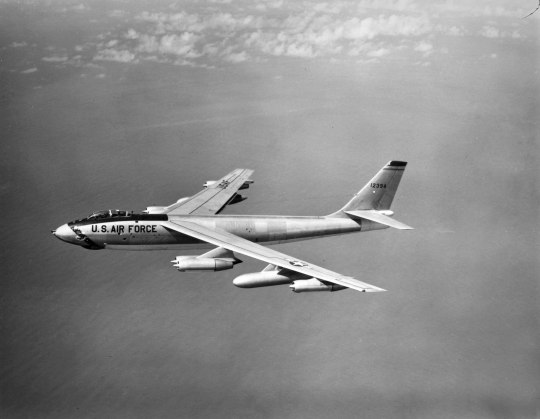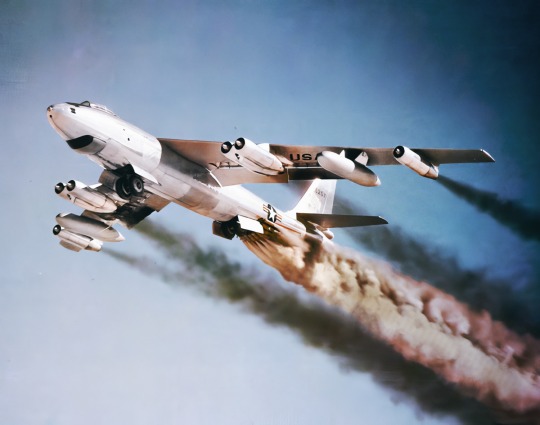#Stratojet
Explore tagged Tumblr posts
Text

The B-29 first flew in 1942. The B-47 first flew in 1947. What a leap in aeronautics we made in those 5 years!
It’s also a reminder that as futuristic as the B-47 was, it was manufactured with WWII technology.
(That’s B-50 at top, a B-29 on the bottom.)
78 notes
·
View notes
Text

B-47E Bomber displayed at the Museum of Flight in Seattle, Washington
#Boeing#B-47#Stratojet#Bomber#nuclear bomber#cold war aircraft#jet#aircraft#air museum#airplanes#aviation#museum
50 notes
·
View notes
Text

Run away on the runway.
#vintage illustration#boeing b-47 stratojet#boeing b-47#b-47 stratojet#b-47#stratojet#jet bombers#military aircraft#vintage aircraft#strategic air command#sac#boeing bombers#strategic bomber#u.s. military#u.s. air force#nuclear bombers
16 notes
·
View notes
Text

#clouds#cloud#planes#plane#airplane#aeroplane#Boeing#Stratojet#bomber#nuclear#turbojet#airforce#usa#usaaf#bw#b&w#blackandwhite#engineering#design#history#historyporn#film
23 notes
·
View notes
Video
youtube
Boeing B-47 Stratojet. Rare Original Documentary
#youtube#B-47#stratojet#boeing#aviation#rare footage#unseen#aircraft#strategic bombing#strategic bomber#cold war#engineering#jato#rato#jet assisted#take off
4 notes
·
View notes
Video
98th SAW Boeing RB-47H Stratojet 53-4280 by Wing attack Plan R Via Flickr: RB-47H-1-BW. C.N. 4501304. Last Unit: 55th SRW (M), Forbes AFB. Withdrawn from service to MASDC 25 May 1967. Declared excess 18 June, 1969. Srapped at MASDC. A total of 32 RB-47H models were built for electronic intelligence (ELINT) missions, as well as three more specialized "ERB-47Hs". Featuring a distinctive blunt, rounded nose and sported blisters and pods for intelligence-gathering antennas and gear, they were designed to probe defenses and collect data on radar and communications signals. The bomb bay was replaced by a pressurized compartment, which accommodated "Crows", or Electronic Warfare Officers (EWOs). There were three Crows on board the RB-47H and two on the ERB-47H. A distinctive bulged radome fairing replaced the bomb bay doors. They retained the tail turret and were fitted with jammers and chaff dispensers. A recognizable difference between the RB-47H and ERB-47H was the latter's distinctive antenna fairing under the rounded nose. The first RB-47H was delivered in August 1955 to Forbes AFB, Kansas. They received a "Mod 44" or "Silver King" program in 1961 to update electronics systems and was recognizable by a large teardrop pod for ELINT antennas upon a pylon under the belly and offset to one side, as well as a pylon-style antenna under each wing beyond the outboard engine. The EWO compartment was cramped with sitting room only and had both poor noise insulation and climate control, making 12-hour missions uncomfortable and tiring. Successful ejection downward through the belly radome was impossible near the ground. Crows sat bobsled-like on the pilot compartment's floor for takeoff and landing. They then crawled encumbered with Arctic clothing and parachute to and from their compartment along an unpressurized maintenance shelf during a temporary level-off at 10,000 ft (3,000 m). Operations were generally flown at night and classified Top Secret. The final RB-47H to be retired from service, 53-4296, was reactivated and fitted with an F-111-style nose to test avionics for the General Dynamics FB-111 in the early 1970s. It was not given any special designation. It is now on display at the Air Force Armament Museum at Eglin Air Force Base, fitted with a bomber nose. ERB-47H was the designation assigned to three RB-47Hs (53-6245, 53-6246 and 53-6249) that were modified as special reconnaissance aircraft designed to detect and locate electromagnetic radio frequency emissions. Like the RB-47H, the ERB-47H was equipped with a bomb bay pod that carried extra equipment and additional crew members, known as Electronic Warfare Officers (EWOs, aka Crows or Ravens). However, the normal crew complement of the ERB-47H was only five as opposed to six for the RB-47H, since the normal Raven One position in the RB-47H was eliminated and filled with additional equipment. Like the RB-47H, the ERB-47H was sometimes sent on some rather dangerous missions near Communist airspace. An ERB-47H was intercepted and fired upon by a pair of North Korean MiG-17s over the Sea of Japan on April 27, 1965. Although heavily damaged, the plane managed to escape and make a safe landing at Yokota AB in Japan. Photo Credit's: Unknown to me (Reprint). Photo marked 1967, RAF Upper Heyford and 98th SAW/Det.1. Inset photos were internet finds and I don't know who to credit them to.
10 notes
·
View notes
Text

RB-47 is one of the few pretty jets imo. Very graceful. NMUSAF
54 notes
·
View notes
Text

A Boeing B-47 Stratojet taking off with the assistance of JATOs (Jet Assist Take off), from the Portsmouth Air Force Base, Portsmouth, New Hampshire.
Date: February 8, 1956
NARA: 6925452
#Boeing B-47 Stratojet#Boeing B-47#B-47 Stratojet#B-47#Bomber#United States Air Force#U.S. Air Force#US Air Force#USAF#JATO#Portsmouth Air Force Base#Portsmouth#New Hampshire#February#1956#my post
60 notes
·
View notes
Text

Boeing B-47 Stratojet
3 notes
·
View notes
Text
B-47 Stratojet

#b 47 stratojet#boeing aviation#military aircraft#military aviation#cold war aircraft#cold war era#usaf#strategic air command#nuclear deterrence
52 notes
·
View notes
Text

Boeing B-47 Stratojet.
63 notes
·
View notes
Text

1950 photograph of a Boeing B-47E Stratojet
58 notes
·
View notes
Text

A KC-135 tanker refueling a Boeing B-47 Stratojet.
#vintage airplane#vintage aircraft#b 47#b-47#boeing b-47 stratojet#boeing b 47 stratojet#military aircraft#military aviation#aviation#boeing#bombers#b-47 stratojet#b 47 stratojet#military bombers#cold war era#u.s. military#stratojet#nuclear bombers#jet bombers#usaf#u.s. air force#air force#strategic air command#sac#kc-135a#strategic bomber
19 notes
·
View notes
Text

USAF Strategic Air Command Boing B-47 Stratojet getting readied.
32 notes
·
View notes
Text

Originally, the Boeing B-47 Stratojet was equipped with internal JATO (Jet Assisted Take-Off) rockets.
➤➤ B-47 Video: https://youtu.be/WVlCdrag0AI
➤➤HD IMAGE: https://dronescapes.video/b47
#b-47#b-47 stratojet#youtube#aircraft#airplane#aviation#dronescapes#military#documentary#aviation history#cold war#boeing#strategic bomber#strategic bombing
22 notes
·
View notes
Video
96th Bomb Wing (M) Boeing B-47E Stratojet 53-2344 by Wing attack Plan R Via Flickr: B-47E-120-BW. C.N. 4501157. Last unit: 96th Strategic Aerospace Wing, Dyess AFB. Declared excess 11 September, 1968. Scrapped at MASDC. Photo Credit's: Unknown to me (Reprint) Photo dated 1962. Each side had 9 RATO rockets on the early models.
#B-47E#53-2344#Boeing#Stratojet#96th_Strat_Aerospace_Wg.#1962#Medium_Bomber#USAF#RATO#96th_Bomb_Wing(M)#Strategic_Air_Command#flickr
4 notes
·
View notes